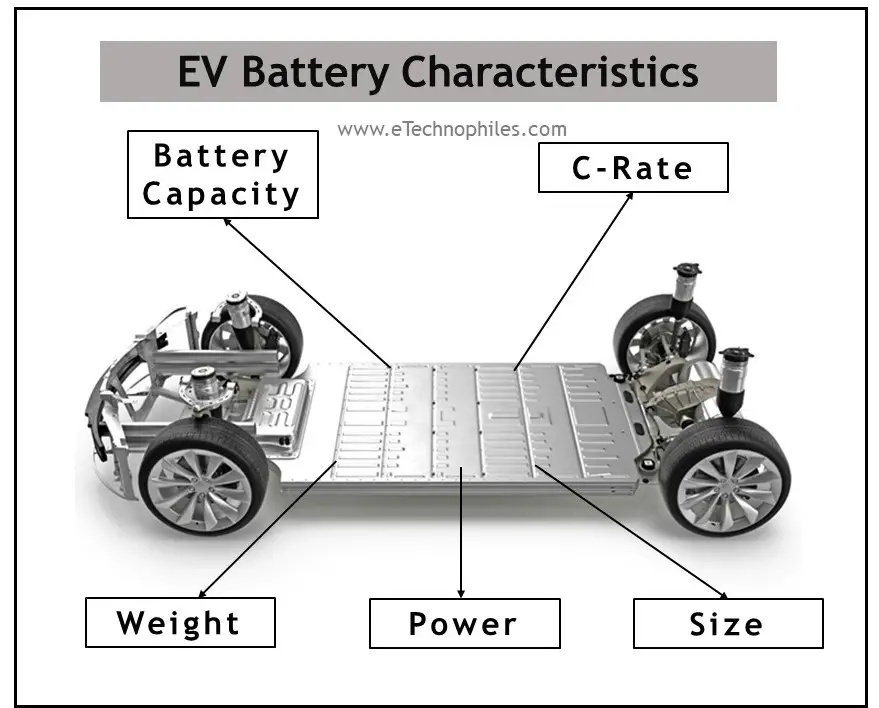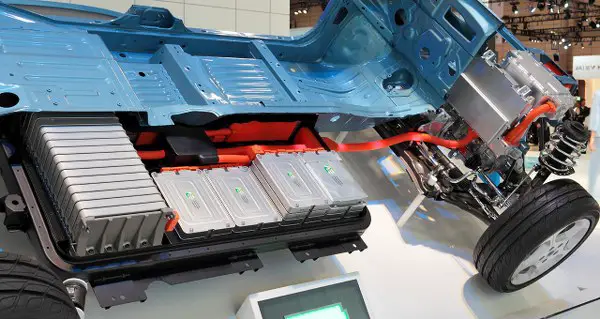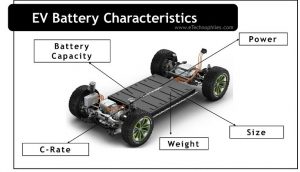Last updated on March 24th, 2023 at 02:19 pm
While the motor may be the one propelling an electric vehicle. EV battery powers the motor, the only energy source for the system. The most popular battery used in EVs is a Lithium-ion battery. While batteries considered suitable for hybrid cars are NiMH.
This article covers some common standard characteristics that define a battery’s performance.
EV Battery Characteristics
The characteristics that define an EV battery performance are listed below:
- Battery Capacity
- C-Rate
- Weight
- Size
- Power
In order to understand them in detail, keep on reading the article.

Battery Capacity
Battery capacity or Energy capacity is the ability of a battery to deliver a certain amount of power over a while. It is measured in kilowatt-hours (product of voltage and ampere-hours). It determines the energy available to the motor and other elements. The rate is dependent on the amount of current being transferred by the battery as the voltage is usually constant. So scientifically it is denoted as only Ah.
For example, the Mahindra e20 has 10kWh energy stored in the battery. It can deliver approx. 208 Ampere current for one hour, at a rated voltage of 48V.
How battery capacity affects range?
A car’s range depends on its battery’s capacity and efficiency of use. Generally, most vehicles will need 20 to 30kW of power on highways for a steady speed. So, accordingly, a 60-kWh battery may allow up to three hours of travel. Though keep in mind that other factors such as speed or outside temperature influence the battery discharge rate.
Measurement of battery capacity
Battery capacity is measured in two different metrics:
Gross or Total Capacity
It is the total amount of energy theoretically held by the battery.
Net or Usable Capacity
This is the energy that a car can actually draw on to propel itself.
The difference is created by automakers to prevent the full charge and discharge of the battery. This damages or shortens the battery’s life.
Battery capacities of some common EVs
- Tesla ModelS/Model X:100kWh battery.
- Mercedes Benz EQS:115 kWh or maybe more.
- Rivian R1T:135kWh battery.
Similar Articles on EV Batteries
C-Rate
A C-rating is used to define the rate at which a battery is fully charged or discharged. For instance, when the vehicle with an 85kWh battery is charged at a C-rate of 1C means that it is charged to its full capacity i.e. 85kW in one hour.
For more than 1C means a faster charge. So, at a 3C rate, the time will be 1/3 times. It means that full capacity can be charged in 20 minutes and simultaneously the power delivered thrice means 255kW. Similarly, lower C-rate means a slower charge, at C/5 means the battery will be charged to its full capacity in 5 hours with 17kW.
How C-Rate affect battery life?
In ideal conditions, the battery might perform at extremely high C-rates. But practically as the C-rate increases, it is difficult for the battery to deliver reliable performance. A higher C-rate increases the degradation rate of a battery, resulting in a reduced range, safety, and lifespan.
This happens due to increased temperature and mass transfer limitations. This is the main obstacle to the wide adoption of EVs, increasing the charging time.
Weight
The major part of an EV’s weight comes from its battery. In general gross weight of a passenger EV, varies from 600kg to 2600kg with the battery weight varying from 100kg to 550kg. More powerful the battery hence greater the weight.
As the weight of the vehicles increases, more work is required to move. Energy density is defined as the amount of energy a battery contains in proportion to its weight. It is represented as Watthours per kilogram (Wh/kg).
How energy density affects EV performance?
The energy to weight ratio must be maintained for the performance and safety of an EV. A battery with a high energy density has a longer battery run when compared to its size.
But if the energy density is too high, it could present a safety issue due to the presence of more active material packed into a cell. This increases the risk of a thermal event. For example, The Tesla Model S battery with 85kWh capacity weighs 540kg.

Size
The size of the battery of an electric vehicle has its own significance. Energy per volume is important to building a compact EV. Volumetric energy density means an amount of energy contained within a certain volume. It is measured in Wh/litre (energy per volume)
With increasing, volumetric density batteries can provide better range without much increase in size. Eventually saving space, weight and even manufacturing cost of the vehicle.
How volumetric density has improved over the years?
There has been significant improvement in the volumetric density of a battery in years. For Li-ion batteries, it used to be 55Wh/litre in 2008, by 2020 it has been increased to 450Wh/litre. Recently announced by CATL that its batteries have a density of over 290Wh/litre for LFP chemistry and over 450Wh/litre for NCM chemistry.
Power
Power gives acceleration to the car and maintains it at a given speed. Though mechanically power is the product of torque and rpm. But in the electrical domain power is the product of voltage and current.
The motor converts electricity into motion, electric power can be interpreted as fuel flowing from tank to engine. This measures the instant power that is flowing through an electrical circuit. It is measured in units as watts (W) or kilowatts (kW= 1000W).
The power for a vehicle is denoted as BHP@RPM. This means the maximum power that a motor can produce and at which rpm/speed. For instance, the Tesla Model S can produce 503hp@6150rpm. Similarly, Tata Nexon EV has a maximum power output of 136hp.
Conclusion
The battery of an EV is an important component of the system. It affects the size, range, and cost of the vehicle. A lot of research is currently going on to improve battery performance. This year-on-year improvement in the given characteristics of a battery plays a significant role in the mass adoption of EV vehicles.
